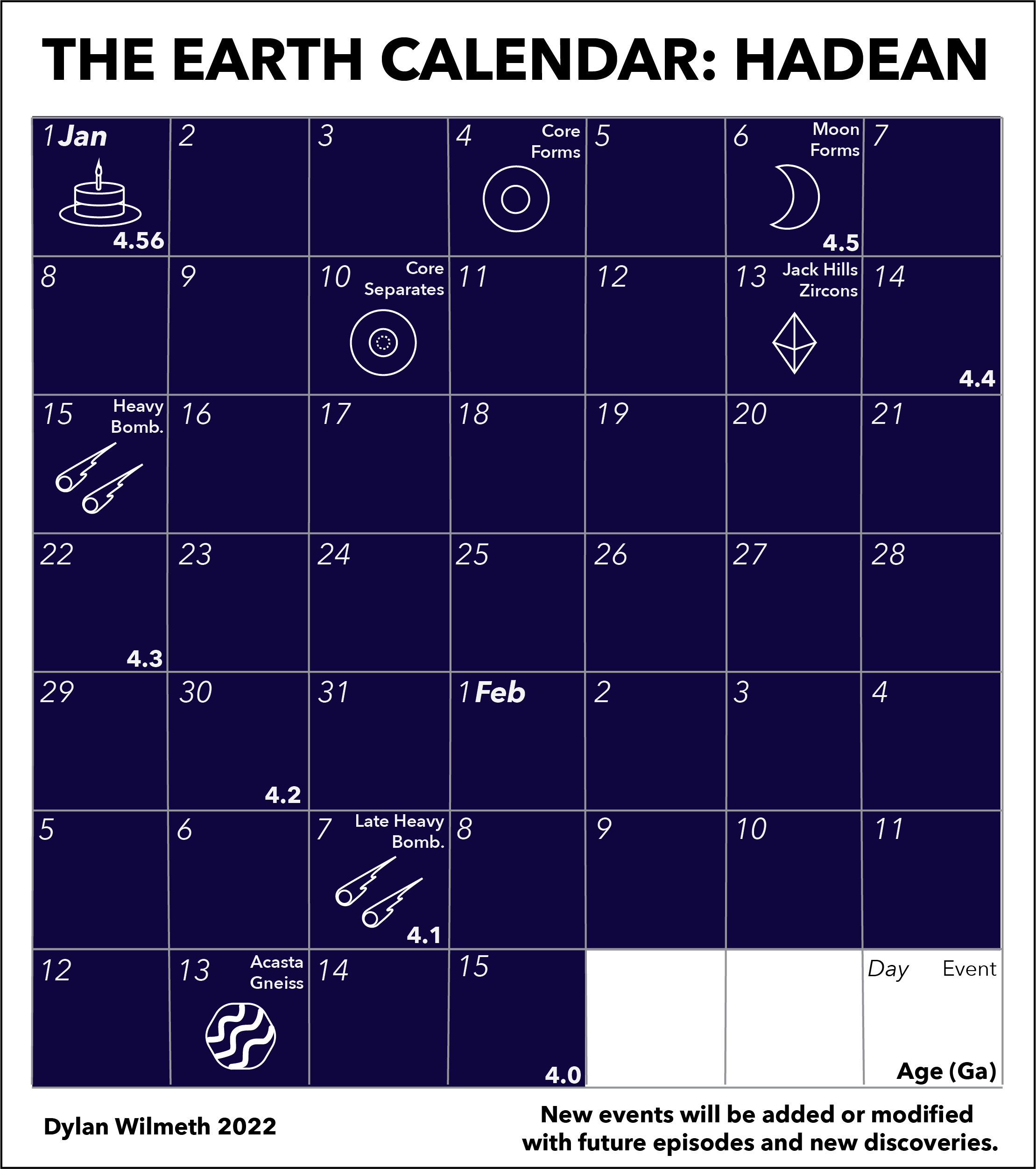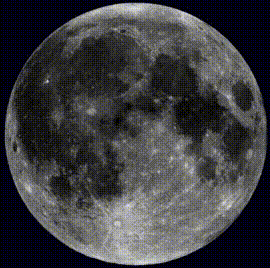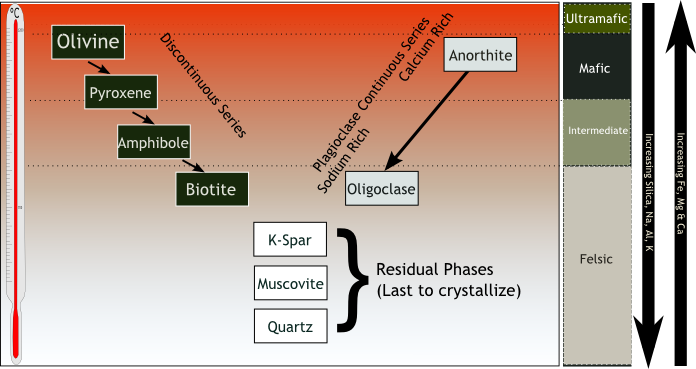9: The Great Gig in the Sky
First, I want to thank my guests from the past two weeks, Drs. Ella Holme and Nadja Drabon. If you haven’t checked out their interviews yet, I would highly recommend it. They’ll give you more detailed insights into the minerals olivine and zircon. Olivine has been our constant companion from the beginning of Earth’s history, and zircons, the hourglasses of deep time, will become our new best friends as we move forward in Earth’s tale.
Speaking of which, I want you all to pat yourselves on the back. We’ve made it through 100 million years of Earth history, the first week of the Earth Calendar. And what a week it’s been. You’ll often hear that the Earth formed from “gas and dust”, but after six episodes, we know that the story has far more flair and excitement.
The Sun formed as hydrogen and helium gathered into a sphere of gravity, possibly pushed by the explosion of a neighboring star. The leftover crumbs formed dozens of small planetary embryos- most were dragged into the Sun. The difference between us and them was an early growth spurt. The Earth grew into a hot ball of magma and liquid metal. Like oil from vinegar, molten rock rose up to become a global magma ocean, while liquid iron sank into the core, never to see the light of day again.
Just when things were settling down, the Earth was gut-punched by one last rogue planet the size of Mars: a world named Theia. Like a cannonball into a swimming pool, the impact splashed some of the magma ocean into space. Unlike a swimming pool, this material pulled itself together into the Moon, magma-rich, but iron-poor.
That story covers the last five episodes and brings us all up to speed, 4.5 billion years ago in the early Hadean. Earth will continue to be pummeled by space debris for a billion years, but after Theia, these impacts are just dirt on its’ shoulder. In fact, the Earth will take ingredients from these asteroids and comets and give itself a makeover in blue and eventually green.
Earth isn’t the biggest planet, it doesn’t have fancy rings or dozens of moons, but it is tenacious and makes beautiful things out of adversity. If you’re in a rough spot yourself, just remember the early days of the Earth and Moon, and maybe you’ll find some comfort in knowing that even planets have bad days, but they can get better.
Today, we’ll start that journey of recovery together. After the Theia impact, Earth is a world without an atmosphere, an ocean, or landmasses. If these were around beforehand, the slate has been wiped clean. Let’s take inventory of what’s left, starting with our newest neighbor- the Moon.
***
Part 1: Our New Neighbor
At the end of Episode 7, we were floating on top of Earth’s magma ocean when Theia so rudely interrupted us. Now that the impact is over, it’s safe to return to the molten surface.
Looking back up from our submarine into the night sky, we see a very different Moon than we’re used to today. First, the size. The modern Moon is nearly half a million km away from the Earth, a quarter million miles. You might have heard that the Moon is slowly drifting away from us at the same rate your fingernails grow. We know this because when we shoot lasers at the Moon- for science or just for fun- the return time keeps getting longer.
If the moon is drifting away from us, then it must have been closer in the past. If we rewind the clock 4.5 billion years, the infant Moon was more than 10 times closer, the same distance as weather satellites. To imagine what the Moon would have looked like in the Hadean sky, look out your window and hold your hand at arm’s length. First, stick your pinky finger up like you’re drinking fancy tea. Your pinky should completely cover up the modern Moon. Now, clench your hand into a wide fist. This is how large the Moon was in the sky just after it was born. Go ahead, slowly lift your fist up at arm’s length over the horizon and imagine that it’s a red-hot ball of magma. And just imagine how long a solar eclipse would take. I leave it up to you whether you find that image beautiful, terrifying, or both.
The Hadean Moon not only appears larger, it is visibly on the run across the night sky. That’s not the Moon’s fault, it’s the Earth’s. Last episode, I compared planets in the solar system to merry-go-rounds on a playground. Each turn represents one planetary day. On Earth and Mars, that’s 24 hours. For the gas giants, days are between 10 and 15 hours. For poor Mercury and Venus, a single day takes two to four Earth months to pass, their merry-go-rounds just barely creeping along. Keep those two in the back of your mind- we’ll return to them shortly.
In contrast, the rogue planet Theia acted like an adult giving an extra big push to the Earth’s merry-go-round. Immediately after this push, the Earth was spinning the fastest it would ever turn. 4.5 billion years ago, one full Earth day was only four hours long, two hours of daylight, two hours of night. If you ever complain that there aren’t enough hours in a day, just be glad you didn’t live in the Hadean. Also, you wouldn’t be able to breathe, but that’s for another day.
Fortunately, like a merry-go-round, things will only get slower and more normal from here. By the end of the Hadean, 500 million years later, the moon will only be two fingers wide in the sky, and a full Earth day will grow to 10 hours long. Ever so slowly, the Hadean world is turning into our home.
There’s one extra effect of this slowing down, one that we can see every night. If we watched our newborn Moon over multiple short Hadean nights, we would notice something else strange. You know, besides the Moon being 10x bigger, moving 6x faster, and being made of red-hot magma pummeled by meteors. Each night, we would see a different face on the Moon, different magma oceans and craters turning in high-definition. Eventually, the Moon’s surface would rotate around to the face we first saw, and the dance would begin again.
That’s right- in the Hadean, there was no dark side of the moon, no secrets to hide.
Fortunately for Pink Floyd, this 360 degree view would not last long.
Today, we always see the same side of the Moon, just with different amounts of shadow. This ever-watching gaze might seem like a unique coincidence, a hint of something more mysterious or romantic about the Moon, but it’s not. There are more than 200 moons in our solar system. Most of them are honestly just up-jumped asteroids, small lumpy potatoes captured by gravity. But 20 of them are large enough to be rounded and smoothed into spheres. All of them show the same face to their planet with a hidden backside just out of reach… just like our Moon.
So how does this happen? Scientists call this phenomenon “tidal locking”, because one face of these giant moons is always “locked” towards a planetary surface. When you hear the word “tidal”, you might instantly think of the ocean. While the Moon is far away, it is heavy enough to pull the oceans several meters toward it using gravity, creating high tides. But the Earth is also pulling on the Moon. This doesn’t mean that mountains and craters on the Moon gently rise and fall like ocean tides.
Instead, it’s easier to imagine the entire Moon like a squishy stress ball. In fact, now’s a good time to pause and take a stress ball out if you have one. When you’re ready, place the ball between your palms like you’re about to applaud someone and gently squeeze it. The ball will push out toward and away from you, aligned between your palms. This is the shape the Earth is pulling the Moon into, though much less extreme. It’s also the shape the Moon pulls on our oceans.
OK, this exercise might be relaxing, but how does it explain why the Moon is always facing us?
Remember, the Moon was initially spinning so we could see all sides. Well, let’s do just that to our ball.
Take your squished stress ball and roll it between your palms, like you’re rubbing your hands to keep warm. The ball is now rotating and showing different sides, but the side facing you is always squished towards you. The same thing was happening to the early Moon. The stretching pull of gravity toward the Earth irresistibly slowed down the Moon’s rotation. After only a few million years, a blink of an eye on the Earth Calendar, one side became fixed to gaze eternally on our surface.
So now we know how the Moon formed, how it slowly started to drift away and how it became locked face-to-face with the Earth. The Moon’s transformation from a looming, fiery eye in the sky to a distant tranquil nightlight is almost complete. The final step is to let it sit and cool from molten magma into solid stone. After all this time looking at astronomy and physics, it’s finally time to do some geology.
Part 2: Before the Man in the Moon
Many children grow up hearing poems and fairy tales where the Moon is a fantastical land made out of cheese. As a child growing up in Wisconsin, America’s dairyland, it was a very sad day when I learned that the Moon is actually made of rock.
So if the Moon isn’t made of Mozzarella, Manchego, or dare I say it… Moon-ster cheese, what is it made of?
A quick glance at the modern Moon tells us that there are two main types of rock - light and dark. Light and dark Moon rocks form patterns that humans have interpreted as a face, a rabbit, or a good gorgonzola. But 4.5 billion years ago, the surface was more like fondue- a red-hot magma ocean, just like the ancient Earth
For more information about how a magma ocean turns into rock over time, I invite you to review Episode 6. In short, as magma cools, minerals begin to crystallize like technicolor snowflakes, or rock candy out of sugar water. We know one of these crystals very well- it’s been in nearly every episode, and we just had a guest speak to me about it. You know it, you love it… it’s olivine!
As olivine crystallizes, it removes iron and magnesium from the surrounding magma, slowly changing the molten chemistry over time. For a similar effect, take a bowl of multi-colored candy like M&Ms. If you only remove and eat green candies, the colors in the bowl will shift, and soon only red or blue candies will be left- you just can’t take any color you like anymore.
The changing chemistry and cooling temperatures in the Moon’s magma ocean eventually start to form new crystals. Today, I’ll introduce you to two new minerals, one dark and one light. Together, they form the Moon’s black-and-white color pallet. More importantly, they are also major ingredients in the Earth’s crust. As important as olivine has been in these early days, you are more likely to see these two newcomers in your everyday life, even if you’ve never heard of them. Let’s give them names and faces.
After olivine, the mysterious dark mineral precipitates next, various shades of black, dark gray or dark green. Its name is pyroxene, which means “fire stranger” in Ancient Greek, since they saw this dark mineral embedded in volcanic glass. It’s also a killer word in the board game Scrabble, containing a Y and an X.
Augite, a pyroxene common on the moon. Sample from Rwanda.
The structure of pyroxene is more complex than olivine, and so it can hold a wider variety of elements. Olivine just contains iron, magnesium, and silicon, but pyroxenes can also have calcium, sodium, aluminum, and many others in various combinations. Remember, olivine has already gobbled up a lot of iron and magnesium, so crystals that come after have to be flexible and use different building blocks. Because pyroxenes can easily trade and add elements, they form a broad family of more than a dozen minerals with similar structures, but for now we can lump them all together.
The two important things to remember are that pyroxene is dark, and it forms right after olivine. In fact, you can think of olivine and pyroxene as close friends- you can usually find them together in Earth and Moon rocks.
Anorthite, the dominant lunar plagioclase. Sample from Italy
Back on the ancient Moon, green olivine and black pyroxene are heavier than the magma they formed in, so they sink like lead weights to form the mantle. As they continue to crystallize, the magma ocean gets shallower and shallower, losing more iron and magnesium.
Finally, a white and light gray mineral begins to crystallize, the last one for today. Its name is plagioclase, or as we call it in the business, “plag”. Plagioclase means “angled fracture” in Ancient Greek, because if you break plag apart with a hammer, the pieces form rhombuses instead of cubes. Consider plag the Leaning Tower of Pisa of minerals- it’s light colored and slightly tilted.
Plagioclase has an even more complex structure than pyroxene, but this complexity actually limits the elements it can hold. Among the tight microscopic framework are keyholes that can only fit sodium or calcium atoms, which have similar sizes. The plag family is therefore much smaller than the pyroxenes, about half a dozen minerals with various ratios of calcium to sodium.
Before we return to the Moon and see if plagioclase sinks or swims, I want to tell you how we know what order these minerals formed in. As with any topic related to Earth’s mantle or magma, we can’t visit these places directly, so scientists have to get creative. In Episode 6, we met Inge Lehmann, who used earthquakes to find Earth’s inner core. In Episode 7, we met Percy Bridgman and others who used high pressure experiments to discover deep mantle minerals. Today, let’s meet Norman Bowen, a Canadian geologist who worked at the Carnegie Institution in Washington, D.C.
As a geology student, I never heard of Drs. Lehmann and Bridgman, though to be fair I was never working in their fields. On the other hand, I would bet good money that most geology undergraduates have heard of Dr. Bowen- it’s impossible to take a mineralogy class without mentioning his name. At the same time Drs. Lehmann and Bridgman were making their experiments, Dr. Bowen was investigating heat.
In 1922, Dr. Bowen would take powdered rock samples and heat them up thousands of degrees, enough to make homemade lava. Then he would sit back, let the lava slowly cool, then throw it into a bucket of water, preserving the minerals in a freeze-frame. Repeating this process at different cooling times, Dr. Bowen would note which minerals formed first. If you guessed olivine, pyroxene, and plag, you’re right. Other minerals formed afterwards as the mixture cooled further, eventually ending with quartz. This chain of minerals is called Bowen’s Reaction Series- it describes how lava and magma turn into rocks, and best of all, it matches mineral patterns we see on the Earth and on the Moon.
In Dr. Bowen’s experiments, light-colored plagioclase always floated to the top, like a cork in water. The same thing happened on the Moon in the final days of its magma ocean. As the Moon finishes cooling down sometime around 4.4 billion years ago, we see the surface turn from molten orange to a pale gray plagioclase crust. Asteroids streaks across the night sky, smashing into the Moon’s face, forming craters large and small. Our nearest neighbor still feels too close for comfort, and the nights are uncomfortably short, but the Moon has chilled out a little bit.
You might ask, “Well, that’s great for plagioclase, but what about the pyroxene that sank? When do the dark rocks appear on the Moon’s surface? Where is the Man In the Moon?” The answers will have to wait, not next episode, but next season. The bright Hadean Moon does have a few dark bruises here and there, but the blotched face we know and love won’t begin to form for another half billion years.
Next episode, we’ll take Bowen’s Reaction Series back to the Hadean Earth and start turning our magma ocean into solid ground.
One final note- I’ve sprinkled nine words and phrases throughout the entire episode that have a common theme, but there’s a tenth one I’ve left out. If you figure out the tenth, tell me in a review on Apple Podcasts, or send me an email at bedrock.mailbox@gmail.com. I’ll give the first winner a special shoutout next episode. One final clue on the theme: prism. Happy hunting!
Bowen’s Reaction Series
***
Thank you for listening to Bedrock, a part of Be Giants Media. As the show takes off, I would love to hear your input on style, topics, and people to interview- you can drop me a line at bedrock.mailbox@gmail.com. See you next time.
Images:
Calendar: Made by Dylan Wilmeth, 2022
Hadean Moonrise: https://commons.wikimedia.org/wiki/File:Earearth.png
Rotating Moon: https://commons.wikimedia.org/wiki/File:LROC_wac643nm_Moon_rotation268.gif
Tidal Bulges: https://commons.wikimedia.org/wiki/File:Árapály_forgatónyomaték.png
Cheese Platter: https://commons.wikimedia.org/wiki/File:International_cheese_platters.jpg
Pyroxene (augite): https://commons.wikimedia.org/wiki/File:Augite_Rwanda.jpg
Plagioclase (anorthite): https://commons.wikimedia.org/wiki/File:Anorthite-rare08-38b.jpg
Norman Bowen: https://commons.wikimedia.org/wiki/File:Norman_Levi_Bowen_(1887-1956).jpg
Bowen’s Reaction Series: https://commons.wikimedia.org/wiki/File:Bowen%27s_Reaction_Series.png
Music:
Once in a Dream by Marc Walloch
The Blue Danube by Johann Strauss; Wilfred Symphony Orchestra
Cafe Bossa by Johathan Boyle
A Look Inside by Doo Dah Music
24 Caprices for Solo Violin by Niccolò Paganini, performed by Elias Goldstein and Christina Lalog








